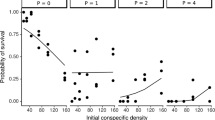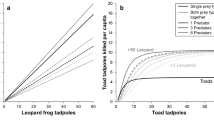Abstract
Laboratory experiments were performed to quantify the combined effects of food abundance (low, high) and predation threat, imposed using a model fish (safe, risky) on fitness correlates (i.e. growth, time to emergence, adult body mass, fecundity, egg size) of the mayfly Baetis tricaudatus. These effects were determined by rearing larvae under different combinations of food abundance and predator threat. Fitness correlates were significantly affected by food abundance, predation threat or the interaction of these factors. High food abundance and the absence of predation threat significantly increased larval growth rates, adult body mass, fecundity, egg size, and decreased time to emergence. Long-term effects of predator threat and food abundance on fitness correlates of B. tricaudatus were compared to previously conducted short-term patch choice trials to test for concordance between short-term measures of patch choice and their potential longer-term fitness consequences. This comparison indicated that patches that were utilized the most were those that yielded the highest fitness benefits. These results suggest that behavioural costs of balancing mortality risk due to predation against food acquisition by B. tricaudatus can have strong fitness consequences.
Similar content being viewed by others
References
Abrahams MV, Dill LM (1989) A determination of the energetic equivalence of the risk of predation. Ecology 70:999–1007
Beers CB, Culp JM (1990) Plasticity in foraging behavior of a lotic minnow (Rhinichthys cataractae) in response to different light intensities. Can J Zool 68:101–105
Blanckenhorn WV (1991) Fitness consequences of foraging success in water striders (Gerris emigis; Heteroptera:Gerridae). Behav Ecol 2:46–55
Bradford RG, Stephenson RL (1992) Egg weight, fecundity, and gonad weight variability among Northwest Atlantic Herring (Clupa harengus) populations. Can J Fish Aquat Sci 49:2045–2054
Butler MG (1984) Life histories of aquatic insects. In: Resh VH, Rosenberg DM (eds) The ecology of aquatic insects. Praeger, New York, pp 24–55
Clifford HF (1970) Analysis of a northern mayfly (Ephemeroptera) population, with special reference to allometry of size. Can J Zool 48:305–316
Cooper SD (1984) The effect of trout on water striders in stream pools. Oecologia 63:376–379
Crowl TA, Covich AP (1990) Predator-induced life-history shifts in a freshwater snail. Science 247:949–951
Culp JM (1989) Nocturnally constrained foraging of a lotic minnow (Rhinichthys cataractae). Can J Zool 67:2008–2012
Culp JM, Scrimgeour GJ (1993) Size-dependent diel foraging periodicity of a mayfly grazer in streams with and without fish. Oikos 68:242–250
Culp JM, Glozier NE, Scrimgeour GJ (1991) Reduction of predation risk under the cover of darkness: avoidance responses of mayfly larvae to a benthic fish. Oecologia 85:163–169
Dill LM (1987) Animal decision making and its ecological consequences: the future of aquatic ecology and behaviour. Can J Zool 65: 803–811
Dixon SM, Baker RL (1988) Effects of size on predation risk, behavioural response to fish, and cost of reduced feeding in larval Ischnura verticalis (Coenagrionidae:Odonata). Oecologia 76:200–205
Dudley TL, D'Antonio CM, Cooper SD (1990) Mechanisms and consequences of interspecific competition between competing stream insects. J Anim Ecol 59:849–866
Duncan DC (1987) Variation and heritability in egg size of the Northern Pintail. Can J Zool 65:992–996
Feltmate BW, Williams DD (1991) Evaluation of predator-induced stress on field populations of stoneflies (Plecoptera). Ecology 72:1800–1806
Flecker AS (1992) Fish predation and the evolution of diel drift periodicity in aquatic insects: evidence from neotropical streams. Ecology 73:438–448
Flecker AS, Allan JD, McClintock NL (1988) Swarming and sexual selection in a Rocky Mountain mayfly. Holarctic Ecol 11:280–285
Gilliam JF, Fraser DF (1987) Habitat selection when foraging under predation hazard: a model and a test with stream-dwelling minnows. Ecology 68:1856–1862
Godfray HCJ, Parker GA (1991) Clutch size, frecundity and parent-offspring conflict. Trans R Soc Zool Lond 332:67–79
Hawkins CP (1986) Variation in individual growth rates and population densities of ephemerellid mayflies. Ecology 67:1384–1395
Lima SL, Dill LM (1990) Behavioral decisions made under the risk of predation. Can J Zool 68:619–640
Lloyd DG (1987) Selection of offspring size at interdependence and other size-versus-number strategies. Am Nat 129:800–817
Ludwig D, Rowe L (1990) Life-history strategies for energy gain and predator avoidance under time constraints. Am Nat 135:686–707
Macchiusi F, Baker RL (1992) Effects of predators and food availability on activity and growth of Chironomus tentans (Chironomidae: Diptera). Freshwat Biol 28:207–216
Nonacs P, Dill LM (1990) Mortality risk vs. food quality tradeoffs in a common currency: ant patch preferences. Ecology 71:1886–1892
Peckarsky BL, Cowan CA, Penton MA, Anderson C (1993) Sublethal consequences of stream-dwelling predatory stoneflies on mayfly growth and fecundity. Ecology 74:1836–1846
Rowe L, Ludwig D (1991) Size and timing of metamorphosis in complex life cycles: time constraints and variation. Ecology 72:413–427
SAS (1988) SAS/STAT users guide. Release 6.03 edition. SAS Institute, Cary, NC
Scrimgeour GJ (1992) Foraging patch selection by the lotic mayfly Baetis tricaudatus. Ph.D. thesis, Department of Biological Sciences, University of Calgary, Alberta, Canada
Scrimgeour GJ, Culp JM (1994) Foraging and evading predators: the effect of predator species on a behavioural trade-off by a lotic mayfly. Oikos 69:71–70
Scrimgeour GJ, Culp JM, Bothwell ML, Wrona FJ, McKee MH (1991) Mechanisms of algal patch depletion: importance of consumptive and non-consumptive losses in mayfly diatom systems. Oecologia 85:343–348
Scrimgeour GJ, Culp JM, Cash KC (1994a) Anti-predator responses of mayfly larvae to conspecific and predator stimuli. J N Am Benthol Soc 13:299–309
Scrimgeour GJ, Culp J, Wrona FJ (1994b) Feeding while avoiding predators: evidence for a forager size-secific trade-off by a lotic mayfly. J N Am Benthol Soc 13:368–378
Sih A (1987) Predators and prey lifestyles: an evolutionary and ecological overview. In: Kerfoot WC, Sih A (eds) Predation. University Press of New England, Hanover, NH, pp 203–224
Sinervo B, Licht P (1991) Proximate constraints on the evolution of egg size, number, and total clutch mass in lizards. Science 252:1300–1302
Skelly DK (1991) Field evidence for a cost of behavioral antipredator response in a larval amphibian. Ecology 73:704–708
Stearns SC, Koella JC (1986) The evolution of phenotypic plasticity in life-history traits: predictions of reaction norms for age and size at maturity. Evolution 40:893–913
Stephens DW, Krebs JR (1986) Foraging theory. Princeton University Press, Princeton, NJ
Sweeney BW (1984) Factors influencing life-history patterns of aquatic insects. In: Resh VH, Rosenberg DM (eds) The ecology of aquatic insects. Praeger, New York, pp 56–100
Sweeney BW, Vannote RL, Dodds PJ (1986) Effects of temperature and food quality on growth and development of a mayfly, Leptophlebia intermedia. Can J Fish Aquat Sci 43:12–18
Ware DM (1975) Relation between egg size, growth, and natural mortality of larval fish. J Fish Res Bd Can 32:2503–2512
Werner EE, Hall DJ (1988) Ontogenetic habitat shifts in bluegills: the foraging rate-predation risk trade-off. Ecology 69:1352–1366
Author information
Authors and Affiliations
Rights and permissions
About this article
Cite this article
Scrimgeour, G.J., Culp, J.M. Feeding while evading predators by a lotic mayfly: linking short-term foraging behaviours to long-term fitness consequences. Oecologia 100, 128–134 (1994). https://doi.org/10.1007/BF00317139
Received:
Accepted:
Issue Date:
DOI: https://doi.org/10.1007/BF00317139




